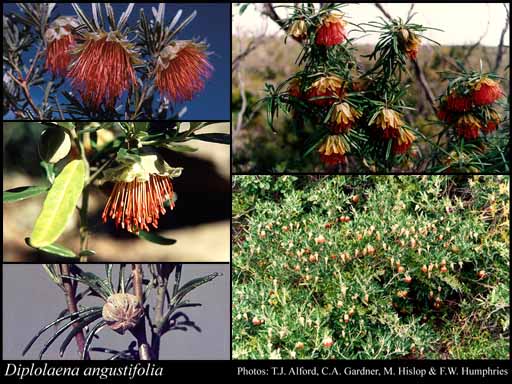- Reference
- Bot.Mag. 70:Tab.4059 (1844)
- Conservation Code
- Not threatened
- Naturalised Status
- Native to Western Australia
- Name Status
- Current
Erect compact or spreading shrub, 0.3-1.5 m high, leaves linear to narrowly oblong, margin recurved to revolute, involucral bracts to 2 cm long. Fl. red/orange, Jun to Oct. White or yellow sand. Limestone hills & rocky ridges, sand dunes.

Scientific Description
Shrub, spines absent; branchlets smooth, without distinct raised glands, +/- cylindrical in cross-section, glabrous. Leaves opposite, simple, 15-50 mm long, 1.5-8 mm wide, flat, the margins recurved or revolute, smooth, without distinct raised glands, covered in hairs or scales, with stellate (star shaped) hairs; stipular excrescences absent. Flowers in a distinct head surrounded by bracts, the outer bracts 12-30 mm long; pedicels 5-8 mm long; calyx minute or absent, smooth, without distinct raised glands; corolla red or orange, petals five, 8.5-10 mm long, imbricate (overlapping), free, glabrous; stamens twice as many as petals, 15-27 mm long, smooth, hairy; anthers 1.5-2.5 mm long, without an appendage. Flowers in June, July, August, September and October. Occurs in the South-West Botanical Province, in the Avon Wheatbelt, Swan Coastal Plain and Geraldton IBRA region(s).
Distribution
- IBRA Regions
- Avon Wheatbelt, Geraldton Sandplains, Swan Coastal Plain.
- IBRA Subregions
- Dandaragan Plateau, Katanning, Lesueur Sandplain, Perth.
- IMCRA Regions
- Central West Coast.
- Local Government Areas (LGAs)
- Carnamah, Coorow, Dandaragan, Gingin, Irwin, Moora, Perth, Wanneroo.